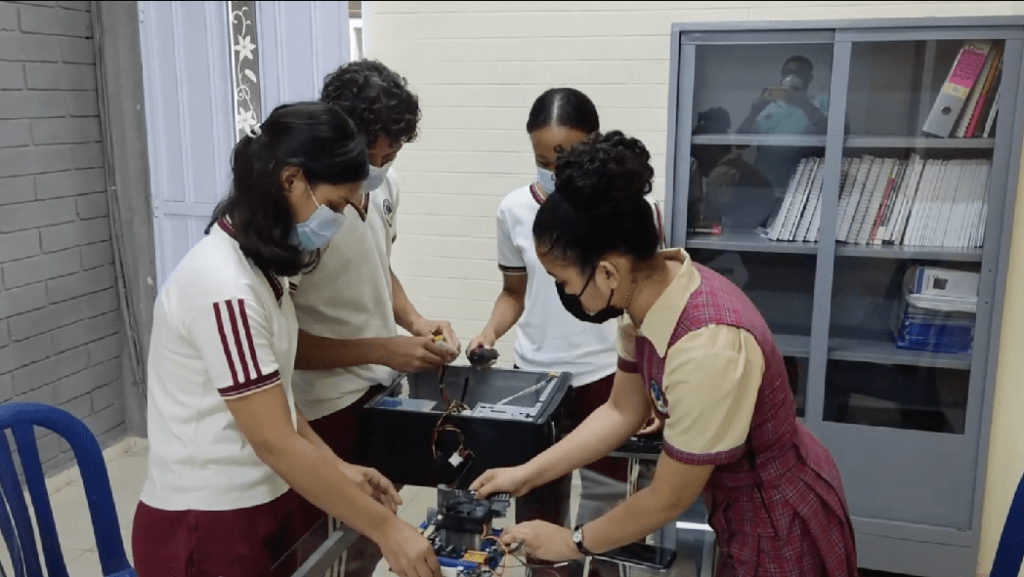Project gallery

Safely Walking: alarm bracelet
Report sent by the Teacher
Edson Anício DuarteSchool
IFSP - CAMPINAS Campinas, São Paulo, BrazilProject team composition
Alessandra Samara Bernardino dos Santos, Joyce Freitas Sousa, Kauan Araujo França, Rosana Gonçalves Nascimento
Age of students
15 to 17 years old, 18 to 20 years oldOther areas of knowledge
Social Sciences or SociologyProject duration
One yearSoft skills
Collaboration, CommunicationSTEM areas
Engineering, TechnologyEmpathy: learning from people’s values and needs
Project objective, problem to be solved, and main actions
The main objective of the project was to develop an alert bracelet, with a sound and light sensor, which will serve to protect women and the LGBT public who experience risky situations on the streets.
The students in the group were listening to a podcast that talked about real crimes and had a localized app, so they came up with the proposal in the Integrator Project class to see if it was possible to do a project similar to this in the discipline. After meetings with the group, it was decided that it would be a bracelet with a light and sound alarm in the first version of the project. It’s interesting, because it’s not just women who are the vulnerable audience: it’s LGBTs, single people, and even children.
We have a methodology for the development of projects; as soon as we define the object of the project, we establish a schedule and organizational chart. With weekly follow-up meetings, we evolve in the development of the project. The problem was identified by the students of the course and they talked with the professors to see if this could be an object of study.
The project was the idea of the young people, who then came to me. Students are encouraged to look for integrative projects based on their observations that are real problems, and from this beginning, they look for teachers who will guide the development of the project in the discipline. At this point in the course, we begin to pass on project management tools to students so that the groups can organize themselves and improve their skills. I always work with student-initiated projects.
Definition: better understanding of the challenges
Deepening into the issue and involvement of the school and local community
Initially, the problem and scope were defined. It was found that this is not just a local issue but has a global scope and is the subject of several research around the world.
With this initial dimensioning, the group defined an Organization Chart and Schedule to start the development of the project. They met and, according to the knowledge of each one in the integrative project discipline, they made a list of the proposed solutions; according to a risk matrix, the bracelet was selected as the most viable proposal to meet the demand.
The risk matrix considered the time to complete the project, cost, and knowledge involved in executing the idea. The group proposed a block diagram of how to integrate the components of the propounded solution. Thus, it is possible to verify the equipment and dimensioning each element. Then, it is possible to prepare the bill of materials, electrical schematic, and mechanical drawing.
During the development, STEAM techniques will be used, a CANVAS Business model will be elaborated and the SWOT matrix analysis of the project will be used.
This project takes place within a regular discipline and we have good adherence from the school community and parents. With the involvement of students, we have a high success rate of projects and even more with the positive impact of Solve for Tomorrow each year this virtuous cycle gets even stronger.
Ideation: developing creative solutions
The development of the solution
In the development of the project, a block diagram was created where it can be seen how all the components were integrated. From there, a list of materials was drawn up, the electrical circuit was simulated in specific software, the group developed the 3D design, and the bench tests were conducted.
The biggest point of attention was to test the prototype as quickly as possible to verify the proof of concept, once this stage is overcome the group moves forward with more confidence.
Prototype: making ideas tangible
The construction of the prototype
The project was finished and presented at science fairs. Today this project is in development to insert the location in the prototype.
Test: putting ideas out into the world
Evaluation of the process and the developed solution
The group’s evaluation was frequent and in weekly meetings, the evolution of the project was always examined against the planned schedule, so the group always had the state of play and what needed to be improved during the project.
Reflections and pedagogical practices
The value of participating in Samsung Solve for Tomorrow
This is a moment where students can be the protagonists of something they created and are exposing themselves. At this age, where teenagers are making many important decisions, it is fundamental to show virtuous paths for this youth. So, I always put a lot of energy into showing and introducing these young people to this fantastic world of Scientific Initiation, which is a very happy trajectory for their lives.
Achievements and advances perceived by the teacher, throughout the process
Autonomy, empowerment, improvement in self-esteem, better group work, and synergy among students.
Challenges faced
We did the projects during the pandemic, so the biggest challenge was finding time to synchronize the time and difficulties of everyone involved. An improvement that I would make would be to include in my teaching practice the introduction of some digital modeling tools; this would greatly facilitate the development of projects for all students.
Learning incorporated into the teacher’s routine and practice
The shyest students have big ideas that fascinate us.








